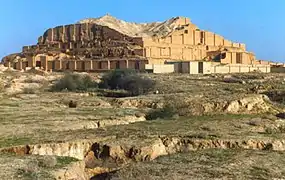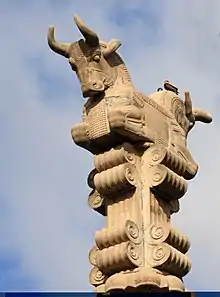Pre-Parsian style
The pre-Parsian style (New Persian:شیوه معماری پیش از پارسی) is a sub-style of architecture (or "zeer-sabk") when categorizing the history of Persian/Iranian architectural development.
This architectural style flourished in the Iranian Plateau until the eighth century BC, during the era of the Median Empire. It is often classified as a subcategory of Parsian architecture.[1]
The oldest remains of the architectural landmarks in this style are the Teppe Zagheh, near Qazvin. Other extant examples of this style are Chogha zanbil, Sialk, Shahr-i Sokhta, and Ecbatana.
Elamite and proto-Elamite buildings among others, are covered within this stylistic subcategory as well.
Gallery
 Sialk necropolis. 3000–4000 BC
Sialk necropolis. 3000–4000 BC Chogha Zanbil ziggurat. 1250 BC
Chogha Zanbil ziggurat. 1250 BC
References
- Sabk Shenasi Mi'mari Irani (Study of styles in Iranian architecture), M. Karim Pirnia. 2005. ISBN 964-96113-2-0 pp.40-51
See also
This article is issued from Wikipedia. The text is licensed under Creative Commons - Attribution - Sharealike. Additional terms may apply for the media files.
